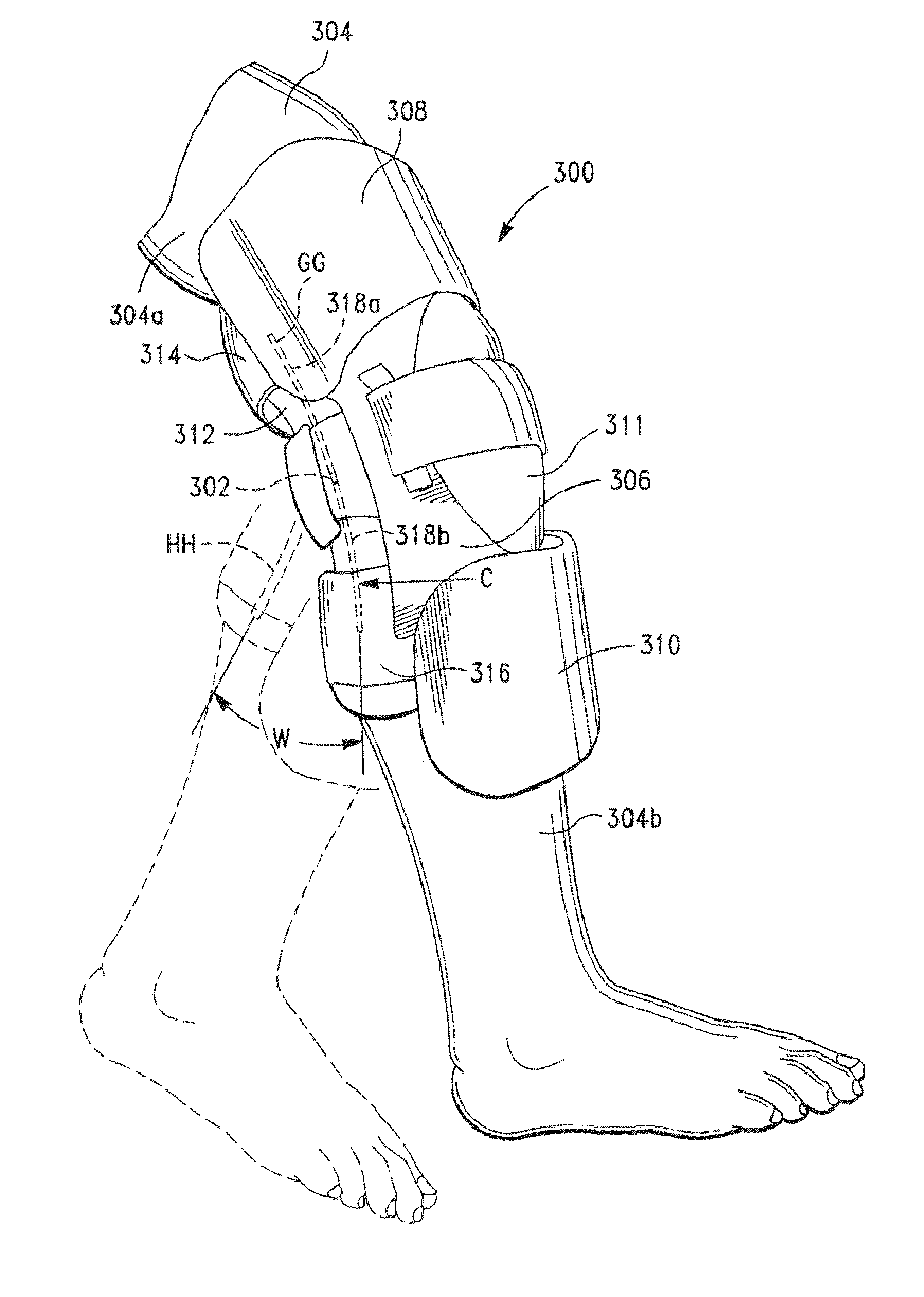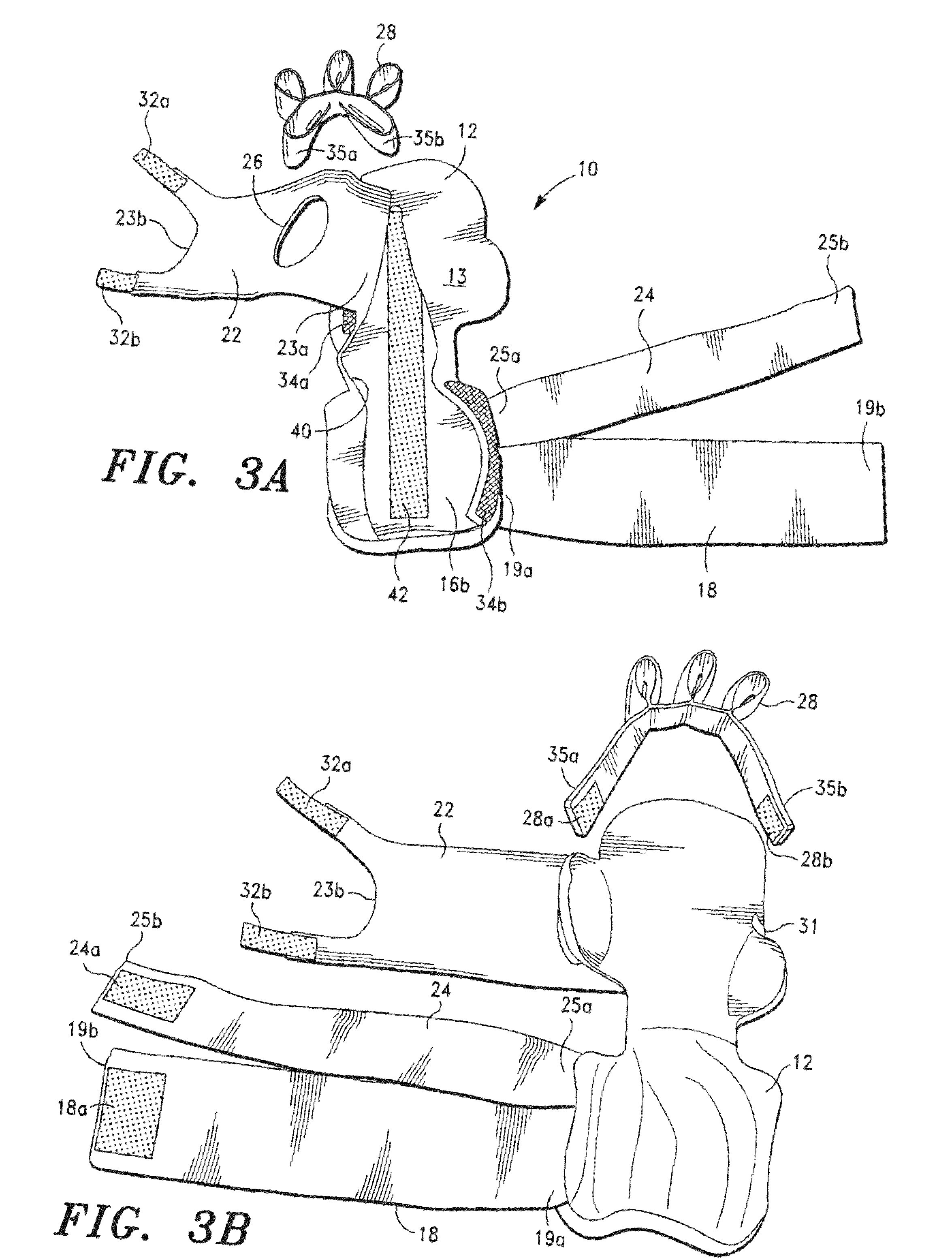Orthosis
a technology of rigidity and orthosis, which is applied in the field of orthosis, can solve the problems of patients losing the range of motion of their joints, and the inability to use an orthosis that allows this type of movement, so as to prevent the loss of range of motion, impede joint movement, and inhibit wrist movemen
- Summary
- Abstract
- Description
- Claims
- Application Information
AI Technical Summary
Benefits of technology
Problems solved by technology
Method used
Image
Examples
first embodiment
Hand / Wrist Orthosis
[0039]FIGS. 1-7 illustrate an orthosis for the hand and wrist in accordance with a first embodiment of the present invention. The hand and wrist orthosis 10 has a cover 12 (FIG. 1), a flexible stiffener 14 (FIGS. 5 & 6), which is positioned inside the cover, and opposed sheets 16a and 16b (FIG. 4), which encase the stiffener 14 for comfort. Cover 12 and opposed sheets 16a and 16b each have a shape that corresponds with the shape of stiffener 14. As shown in FIGS. 1-3C, a wrist strap 18 and one or more hand straps 22 and 24 are joined to cover 12 for securing a hand 20 and wrist 21 to the cover and stiffener. Further, a finger retainer 28 is joined to the cover and has a plurality of loops 29a, 29b, and 29c that respectively receive fingers 30a, 30b, and 30c in order to secure them to the cover. The loops 29a, 29h, and 29c are preferably spaced so that the fingers may alternatively reside between adjacent loops. Hand 20 also has a pinkie finger 30d resting on the t...
second embodiment
Foot Orthosis
[0057]Referring now to FIGS. 9-11, a foot orthosis in accordance with a second embodiment of the present invention is shown as 100. The foot orthosis has an L-shaped splint 102 with a first end 104 positioned adjacent to a posterior lower leg 106 and an opposite heel end 108 positioned underneath a heel 110. A flexible stiffener 112, shown in FIGS. 10 and 11, is joined to the heel end 108 of the splint. Preferably the stiffener is joined using a retaining clip 114 and one or more rivets 116a, 116b, and 116c. As shown in FIG. 9, the stiffener is positioned underneath foot 113 and toes, one of which is identified as 115, to impede downward movement of the foot and / or toes.
[0058]Referring to FIG. 11, retaining clip 114 is U-shaped with two legs 115a and 115b each having a free end 114a and a joined end 114b. The distance between the free ends 114a of the legs 115a and 115b is slightly greater than the combined thickness of the heel end 108 of the splint and the stiffener 1...
third embodiment
Elbow Orthosis
[0064]FIGS. 12-15 show an elbow orthosis 200 in accordance with a third embodiment of the present invention. The elbow orthosis has a tubular brace 202 that receives an arm 204 and extends across an elbow (not shown) from an upper arm 204a to a forearm 204b. As shown in FIGS. 13B and 13C, hook material 203a and 203b (FIG. 13B) is stitched to the inner surface of brace 202, and loop material 205a and 205b (FIG. 13C) is stitched to the outer surface of the brace. To secure the brace 202 to arm 204 the arm 204 is positioned over brace 202 so that the medial side of the elbow (not shown) is adjacent to the hole 202a shown in FIG. 13B. Then the brace 202 is wrapped around the arm 204 so that the hook material 203a and 203b engages the loop material 205a and 205b, respectively.
[0065]The brace also has one or more adjustable upper and lower straps 206a and 206b to secure the brace to arm 204. As shown in FIG. 13A, upper strap 206a has one end 207a that is stitched to brace 20...
PUM
 Login to View More
Login to View More Abstract
Description
Claims
Application Information
 Login to View More
Login to View More - R&D
- Intellectual Property
- Life Sciences
- Materials
- Tech Scout
- Unparalleled Data Quality
- Higher Quality Content
- 60% Fewer Hallucinations
Browse by: Latest US Patents, China's latest patents, Technical Efficacy Thesaurus, Application Domain, Technology Topic, Popular Technical Reports.
© 2025 PatSnap. All rights reserved.Legal|Privacy policy|Modern Slavery Act Transparency Statement|Sitemap|About US| Contact US: help@patsnap.com



